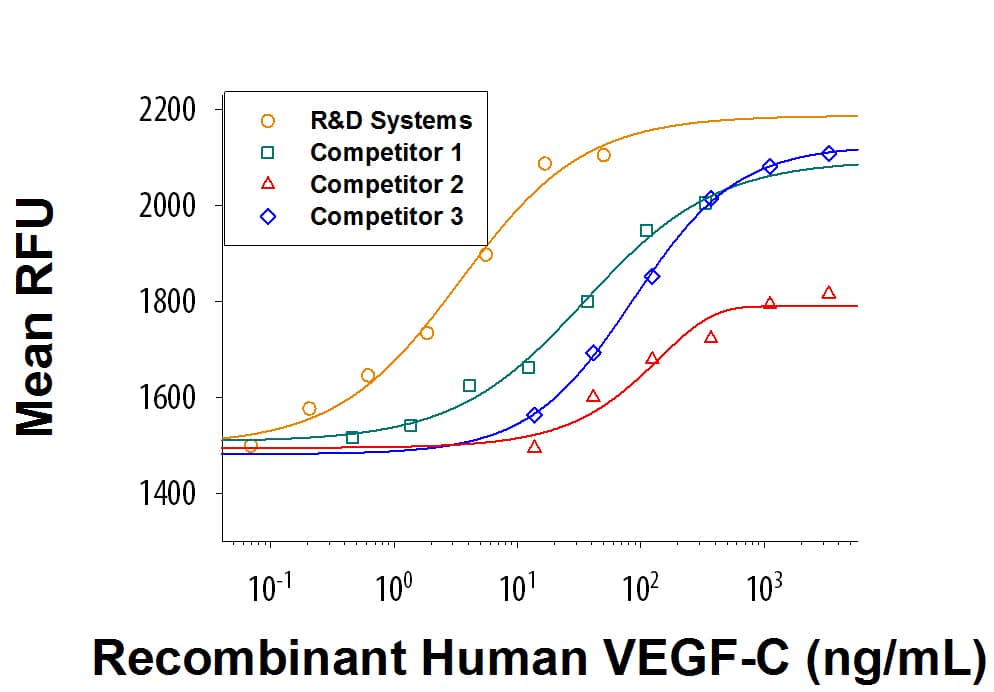Recombinant Human VEGF-C Protein Best Seller
R&D Systems, part of Bio-Techne | Catalog # 9199-VC

Key Product Details
Source
Accession #
Structure / Form
Conjugate
Applications
Product Specifications
Source
Ala112-Arg227
Purity
Endotoxin Level
N-terminal Sequence Analysis
Predicted Molecular Mass
SDS-PAGE
Activity
The ED50 for this effect is 1.5-9 ng/mL.
Scientific Data Images for Recombinant Human VEGF-C Protein
Recombinant Human VEGF-C Protein Bioactivity
Recombinant Human VEGF-C (Catalog # 9199-VC) induces HMVEC human microvascular endothelial cell proliferation. The ED50 for this effect is 1.5-9 ng/mL. The ED50 for the three competitors is >30 ng/mL, which is at least more than 10-fold weaker.Formulation, Preparation and Storage
Carrier Free
What does CF mean?CF stands for Carrier Free (CF). We typically add Bovine Serum Albumin (BSA) as a carrier protein to our recombinant proteins. Adding a carrier protein enhances protein stability, increases shelf-life, and allows the recombinant protein to be stored at a more dilute concentration. The carrier free version does not contain BSA.
What formulation is right for me?In general, we advise purchasing the recombinant protein with BSA for use in cell or tissue culture, or as an ELISA standard. In contrast, the carrier free protein is recommended for applications, in which the presence of BSA could interfere.
Carrier: 9199-VC
| Formulation | Lyophilized from a 0.2 μm filtered solution in HCl with BSA as a carrier protein. |
| Reconstitution | Reconstitute at 250 μg/mL in 4 mM HCl. |
| Shipping | The product is shipped at ambient temperature. Upon receipt, store it immediately at the temperature recommended below. |
| Stability & Storage | Use a manual defrost freezer and avoid repeated freeze-thaw cycles.
|
Carrier Free: 9199-VC/CF
| Formulation | Lyophilized from a 0.2 μm filtered solution in HCl. |
| Reconstitution | Reconstitute at 250 μg/mL in 4 mM HCl. |
| Shipping | The product is shipped at ambient temperature. Upon receipt, store it immediately at the temperature recommended below. |
| Stability & Storage | Use a manual defrost freezer and avoid repeated freeze-thaw cycles.
|
Background: VEGF-C
References
- Chen, J.-C. et al. (2013) Int. J. Mol. Sci. 14:88.
- Joukov, V. et al. (1996) EMBO J. 15:290.
- Kukk, E. et al. (1996) Development 122:3829.
- Joukov, V. et al. (1997) EMBO J. 16:3898.
- Karkkainen, M. et al. (2004) Nat. Immunol. 5:74.
- Jeltsch, M. et al. (1997) Science 276:1423.
- Makinen, T. et al. (2001) Nat. Med. 7:199.
- Laakkonen, P. et al. (2007) Cancer Res. 67:593.
- Hoshida, T. et al. (2006) Cancer Res. 66:8065.
- Mandriota, S.J. et al. (2001) EMBO J. 20:672.
- Skobe, M. et al. (2001) Nat. Med. 7:192.
- Padera, T.P. et al. (2002) Science 296:1883.
- Tammela, T. et al. (2008) Nature 454:656.
- Cao, Y. et al. (1998) Proc. Natl. Acad. Sci. 95:14389.
Long Name
Alternate Names
Gene Symbol
UniProt
Additional VEGF-C Products
Product Documents for Recombinant Human VEGF-C Protein
Product Specific Notices for Recombinant Human VEGF-C Protein
For research use only
